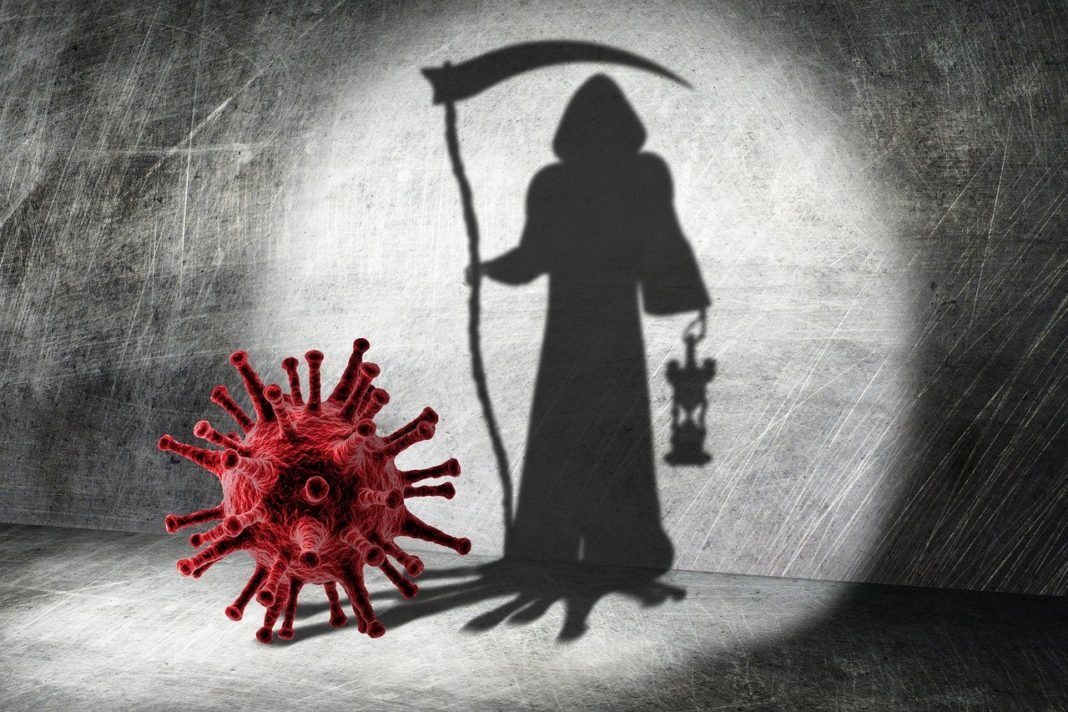Gender based violence is an affliction that women worldwide have been fighting since ages. However the efforts to claim dignity and equality receive a setback during the emergency situations such as pandemics as the multifarious hardships faced by the general populace result in widespread frustration, economic struggles, and a range of negative impacts. Entrenched patriarchy and gender supremacy make women a channel to release this negativity. They stand to lose on multiple fronts as the weaker sex; increased mental stress, denial of dignity, safety, economic independence, access to health services, and traditional support systems inflict a double impact of pandemics on women. This paper delves into the various facets of Covid-19 induced violence against women, records the efforts done by the governments worldwide to tackle the same and suggests ways to not only mitigate the present crisis at homes but also to cure the deeper malaise that deprives women of a dignified space in homes and in the society.
Gender inequality has been a persistent issue of concern and is the main cause behind violence against women. Violence can be physical, mental or denial of their civic rights. Rise in gender-based violence is a common phenomenon worldwide but during emergency situations, it is seen to have multiplied. Women become the target and conduit of releasing the frustration and a plethora of negative emotions that such situations trigger in their wake.
The most comprehensive definitions of violence against women (VAW) were adopted by the UN General Assembly in 1993. The Declaration on the Elimination of Violence against Women defines it as following: “the term ‘violence against women’ means any act of gender based violence that results in, or is likely to result in, physical, sexual or psychological harm or suffering to women, including threats of such acts, coercion or arbitrary deprivation of liberty, whether occurring in public or in private life.” 1
The UN Women has warned that the number of sexual and/or physical abuse by an intimate partner is likely to increase as security, health, and money worries heighten tensions and strains are accentuated by cramped and confined living conditions due to the ongoing Covid-19 pandemic.2
Gender Based Violence during Covid-19
Humanitarian emergencies intensify existing violence and lead to additional forms of violence against women. As different parts of the world have gone into varying degrees of lockdowns, shutdowns, curfews, social distancing etc, in the face of the ongoing coronavirus outbreak, there is worrying trend emerging in the form of rising cases of domestic violence..3
As per World Health Organization, globally, 1 in 3 women worldwide have experienced physical and/or sexual violence by an intimate partner or sexual violence by any perpetrator in their lifetime. Violence against women tends to increase during every type of emergency, including epidemics. Women who are displaced, refugees, and living in conflict-affected areas are particularly vulnerable. While data are scarce, reports from China, the United Kingdom, the United States, and other countries suggest an increase in domestic violence cases since the COVID-19 outbreak. According to one report, the number of domestic violence cases reported to a police station in Jingzhou, a city in Hubei Province, tripled in February 2020, compared to the same period the previous year. 4
In France, reports of domestic violence have increased by 30% since the lockdown on March 17. In Cyprus and Singapore helplines have registered an increase in calls of 30% and 33%, respectively. In Argentina emergency calls for domestic violence cases have increased by 25% since the lockdown on March 20. Increased cases of domestic violence and demand for emergency shelter have also been reported in Canada, Germany, Spain, the United Kingdom and the United States.5
In India after lockdown was announced on 25 March 2020, the number of domestic violence complaints received by the National Commission for Women (NCW) had doubled. From 30, in the first week of March, the number of complaints rose to 69 between 23 March and 1 April. According to Rekha Sharma, the Chief of the National Commission of Women, New Delhi, “Domestic cases have doubled than what is was before the lockdown. The cases of domestic violence are high in Bihar, Uttar Pradesh, Haryana and Punjab.” She explains that the amplification of the domestic violence cases is because the men are at home and they are drawing out their annoyance on women and they repudiate to partake in domestic chores. Women are also restricted within the fore-walls of their house and they cannot share their anguish and pain with anybody.6
The patriarchal make up of our society has resurfaced with renewed vigour during the lockdown, manifest in increased domestic violence. Women are becoming the target of men’s frustration due to any reason- be it lockdown, job loss, denial of access to alcohol etc. Not to mention the enhanced work of feeding, tolerating and keeping in good humour everyone at home during the lockdown. Their access to support system to friends and family has also been restricted. The WHO has brought out data on increased unwanted pregnancies and unsafe abortions due to lack of access to health facilities. The health impacts of violence, particularly intimate partner/domestic violence, on women and their children, are significant. Violence against women can result in injuries and serious physical, mental, sexual and reproductive health problems, including sexually transmitted infections, HIV, and unplanned pregnancies.7
Economic Fall-Out: Further Catalyst to VAW
The economic fall-out of Covid-19 is also expected to hurt the women most. Women disproportionately work in insecure, lower-paid, part-time and informal employment, with little or no income security and social protection, such as health insurance, and are therefore less protected from economic recession in times of crisis.8 In India, female labour force participation is merely 23%. Now, as jobs get retrenched and due to social distancing the care of elderly and children falls from domestic help to women, one of the couple will have to opt out of work. Since women as a convention are paid lesser, it will be economically prudent for them to stay at home. However, it will cost heavily on the front of women empowerment, their individual identity as a human being, the utilization of their potential and their economic independence. The stark socio-economic inequalities will place the most vulnerable groups of women at an even higher risk of violence. In the aftermath of the crisis, violence against women and girls will continue to escalate, at the same time as unemployment, financial strains and insecurity increase. A loss of income for women in abusive situations makes it even harder for them to escape. The financial impact of COVID-19 will also affect the capacity of local women’s organizations, to advocate for policy reforms on violence against women and girls and for service provision to survivors of violence over the long-term.9 Will this pandemic push back the progress done on women empowerment? This deserves a serious thought.
Cyber Abuse
Before COVID-19, one in 10 women in the European Union reported having experienced cyber-harassment since the age of 15 (including having received unwanted, offensive and sexually explicit emails or SMS messages, or offensive, inappropriate advances on social networking sites). During COVID-19 and moving restrictions, the use of online platforms has increased in the last few weeks. This has been used by some as an opportunity to groom young people into exploitative situations. According to Europol, online activity by those seeking child abuse material is increasing. Millions of women and girls are using videoconferences frequently, sometimes daily, to work and study. According to diverse media outlets, social media posts and women rights experts, different forms of on-line violence are on the rise including stalking, bullying, sexual harassment, and sex trolling. Examples include unsolicited pornographic videos while they are dialling into a social event via a virtual chat room.10
Effect of Pandemic on Frontline Support Services to Women
The surge in COVID-19 cases is straining even the most advanced and best resourced health systems to the breaking point, including those at the front line in violence response. Domestic violence shelters are reaching capacity, or unable to take new victims due to lockdown and social distancing measures. In other cases, they are being re-purposed to serve as health centers.11 Increase in reports of domestic violence is happening at the same time that services are being compromised. Life-saving care and support to women who experienced violence (i.e. clinical management of rape and mental health and psycho-social support) may be disrupted when health service providers are overburdened and preoccupied with handling COVID-19 cases. Even where basic essential services are maintained, a collapse in a coordinated response between different sectors, i.e., health, police and justice and social services response, and social distancing will mean that sectors will be challenged to provide meaningful and relevant support to women and girls who are experiencing violence.12
Responding to Violence against Women during Pandemics
The awareness of the wide ranging impact of violence against women as a complex web of rights violations is still not widely incorporated into mainstream policy and development discussion. A concerted action to prevent and reduce both physical and psychological abuse in their early stages is crucial. Yet for most women throughout the world living with deeply entrenched traditions that silence them and circumscribe their options, neither individuals nor institutions are enabled to fulfill or protect this most basic right (Burton, B. et al, 2000).
However substantial body of literature which reviewed how services respond to violence against women effectively has been documented, studies such as “Domestic Violence in India II: Exploring Strategies, Promoting Dialogue” (ICRW. Information Bulletin, 2001, “Ending Violence against Women: Programming for Prevention, Protection and Care” (UNFPA. 2005), “Women’s Mental Health: An Evidence Based Review” (World Health Organization. 2000) etc. provide information on how to respond to VAW. It must be acknowledged that the magnitude of women suffering from violence is disproportionately from domestic abuse or intimate partner violence, than other types of crimes committed against women. Thus, domestic violence (DV) is likely to have a greater bearing on the service providers which necessitates service providers to have a statutory responsibility to respond to domestic abuse than for example, to rape or sexual assault. This does not mean to undermine the needs of survivors of rape or sexual assault, or survivors of child sexual abuse (Greenan, L. 2004).13
Developing a holistic and multidisciplinary approach to the challenging task of promoting families, communities and States that are free of violence against women is necessary and achievable. A wide strategic framework on violence against women might include consideration of the types of services on offer to women, and how to ensure that they reflect what women are looking for from services. Research reveals that, relatively few women who experience abuse access formal services such as medical help, police assistance, or counseling and shelter services. If and when women reach out, they first seek the support of people they know-family, friends, workmates, sometimes referred to as the “site of first response” and so more attention should be paid to the development of information and support for the general public. Those that come forward often do only after abuse has escalated to a point of severe, life-threatening violence. Examination of the data from organizations serving the needs of abuse women indicated that when they did seek help, their primary concern was to prevent the violence. Many women requested help in changing attitudes and behaviors that contribute to domestic violence (ICRW, 2001). Research reveals, for example, that women value a more proactive approach to follow-up support and advocacy.
Another area is of consideration could be the review of the mechanics of multiagency partnerships. Information and support could also be provided such as workplace campaigns, awareness raising programs in schools and general public education campaigns which could greatly enhance the level and quality of informal support available to women from those closest to them. Equality, partnership between women and men and respect for human dignity must permeate all stages of the socialization process. Educational systems should promote self-respect, mutual respect, and cooperation between women and men. Another strategy is a systematic media campaign on domestic violence to bring into public forum and generate the type of dialogue needed to shatter entrenched beliefs that violence may be a “normal” way to resolve conflict. Rather than spotlighting women as victims in non-negotiable situations, media should portray women as agents capable of changing their lives. An alternative image of male behaviors is critical to depict the broad canvas of manhood (ICRW, 2001). Finally, but most importantly, seeking the views of women themselves should be critical. (Greenan, L. 2004).14
Technological Assistance
Technology can provide women a faster and less conspicuous way to seek help, especially in situations when physical movement is restricted, such as lockdowns. Recently, as a means to assist violence-affected women during Covid-19, some innovative solutions have come up from around the world. In Madrid, Spain, an instant messaging service with a geolocation function offers an online chat room that provides immediate psychological support to survivors of violence. In the Canary Islands, Spain, women can alert pharmacies about a domestic violence situation with a code message “Mask-19” that brings the police in to support. In Cumbria, UK, police have enlisted postal workers and delivery drivers in looking out for signs of abuse. A popular app called ‘Bright Sky’ provides support and information to survivors, but can be disguised for people worried about partners checking their phones.15
In India, the National Commission for Women announced a WhatsApp number to receive complaints, to be more accessible to women who find themselves in abusive homes. However, as Jaya Valenkar of the women’s rights organisation, Jagori, told India Spend, “If a woman has to complain or seek help from a helpline about her family being abusive, she needs to have a landline or mobile phone while being 100% sure that she is not being overheard–whether it is her marital home or natal home.” With almost 57% of the women in India not having access to phones, their options for registering complaints under the lockdown are limited.16
Virtual Justice System
In Colombia the government has issued a decree to guarantee continued access to services virtually, including legal advice, psychosocial advice, police and justice services including hearings. Other countries are using virtual means to keep the justice system operating, such as having a domestic violence survivor teleconference into a court proceedings.17
Comprehensive Response
Since pandemics affect women on multiple fronts and gender- based discriminations and violence are exacerbated in such situations, a holistic, multi-stakeholder approach is essential to ensure their safety, dignity and well-being. From a gender perspective, pandemics do not remain merely a health emergency, but encompass a wide range of debilitating effects including social, economical, and psychological onslaught. Thus, a single component in isolation may not be adequate to form a comprehensive support system for women during pandemics. A coordinated and thoughtful effort covering prevention, protection and deterrence and empowerment is required. In this regard the UN Women suggest the following steps to nations:
- Allocate additional resources and include evidence-based measures to address violence against women and girls in COVID-19 national response plans.
- Strengthen services for women who experience violence during COVID-19.
- Treat services for women who experienced violence as essential services. Build capacity of key services to prevent impunity and improve quality of response.
- Train first responders on psychosocial support, including health workers, law enforcement and court officials and emergency shelter and counselling staff still operating during the crisis.
- Ensure support for grassroots women’s rights organizations, especially those that provide essential services to hard-to-reach, remote and vulnerable populations.
- Ensure women’s organizations and women’s community organizations participate in the decision-making processes so that needs and concerns are identified and included in prevention of and responses to violence against women and girls.
- Consider the role of women’s organizations in recovery plans and the longer-term solutions to address the increase of violence against women and girls during COVID-19. Ensure sex-disaggregated data is collected to understand the impact of COVID-19 on violence against women and girls and inform the response.
- Collect sex-disaggregated data on the incidence of violence against women and girls, including domestic violence (including psychological and economic violence) and sexual violence, recording place of occurrence.
- Collect data on the needs and capacity of services to respond to the increased demand from women and girls in the context of COVID-19.
- Ensure any data collection efforts does not put women and girls at greater risk of violence and distress.
- Proactively challenge gender stereotypes and harmful masculinities, accentuated under COVID-19 circumstances (e.g. increased household care work for women, financial insecurity/unemployment), with targeted messages for men in order to encourage healthy ways of coping with stressful situations.
- Engage with media outlets to continue to raise the visibility of increased violence against women and girls, demonstrating how the risk factors that drive violence are exacerbated in the context of COVID-19.
- Provide information, including through public service announcements, to survivors of domestic violence, for example, on service referrals, or how to safely continue employment, using accessible formats for different groups of women.18
In addition to constituting support services, it is essential to ensure speedy access, even in the rural and remote areas. In this regard, the microfinance institutions, particularly those with an SHG (self-help group) focus, can play a much more important role. Leveraging their pre-existing networks, they can dually serve as complaint points as well as providers of livelihood support in these times of financial hardship.19
Conclusion
Confining people to homes in order to prevent community transmission of Covid-19 has led to an undesired side-effect- increase in violence against women. While the governments and organizations around the world make economic revival policies, it is imperative to pay attention to women’s issues, proactively perceive the possible fallouts and take steps to ameliorate them. Whether it is ensuring their participation in the economy by means of small scale business or providing them access to online education, health facilities and job opportunities, or ensuring their mental well-being by access to helplines and counsellors, it is high time to stop clubbing them in general categories such as migrants, entrepreneurs, households. Their issues are gender-specific and the steps to deal with them must include that sensitivity. While formulating plans and strategies to deal with Covid-19 and its fallouts, the government needs to prominently figure in the ways to support violence –affected women. The government machinery including administrators and law enforcement agencies needs to be sensitized to this effect and a strong message from them that impunity on this front will not be tolerated, will act as deterrent. Police and Justice Personnel must ensure that incidents of violence against women and girls are given high priority and care must be taken to address the manifestations of violence emerging in the context of COVID 19.20 Contact numbers of health services, rape crisis centres, shelter homes, legal aid and helpline numbers should be identified and widely publisized. The community can play a vital role in reporting or providing assistance in such cases by either counselling or if needed, by providing access to formal help.
Pandemics often heighten gender inequities and affect men and women differently. Disasters expose and intensify the systemic and structural cracks in the current system and lockdown has shown that gender-blind policies could worsen these issues and leave women and girls more vulnerable than ever. As the lockdown begins to be lifted or partially lifted around the country, India urgently needs gender-sensitive policies addressing the increasing violence against women, the widening gender disparities in labor force participation, rising school dropouts and malnutrition among girls, and women’s disproportionate unpaid work and caregiving responsibilities.21
Violence against women calls for a change of attitude at the social front, as most of the perceptions which are carried forward by individuals are imbibed during their childhood. Violence within homes and work places requires strict enactment of the laws against violence which have already been formed by the government. At the same time, enlightening the people is equally imperative, by making it part of the school curriculum and arranging lectures. In case of alcoholic violence, psychologists and medical practitioners can counsel the addicts. The efforts being made by the NGOs in creating awareness and extending help to the victims is commendable, but the society can free itself of this problem only with the wholehearted support of the entire populace. After every major upheaval, revolution, war or pandemic, women play a major role in rebuilding theirs and their community’s life and they will again do so. Therefore, it is essential to recognize these unsung warriors in the families and in the public spaces, remove the structural and behavioral prejudices to stop treating them as serving machines and give them the dignity and respect they deserve.
References
- Declaration on the Elimination of Violence against Women Proclaimed by General Assembly resolution 48/104 of 20 December 1993, United Nations, p. 2.
- The Shadow Pandemic: Violence Against Women and Girls and COVID-19, UN Women, cited from:
https://www.unwomen.org/media/headquarters/attachments/sections/library/publications/2020/issue-brief-covid-19-and-ending-violence-against-women-and-girls-infographic-en.pdf?la=en&vs=5348 - Singh Praveen K, Monster at Home: Rising Cases of Domestic Violence during Lockdown, Bihar Connect: Empowering Development, April 30, 2020.
- COVID-19 and violence against women: What the health sector/system can do, World Health organization, 26 March 2020, cited from:
https://www.who.int/reproductivehealth/publications/emergencies/COVID-19-VAW-full-text.pdf - The Shadow Pandemic: Violence Against Women and Girls and COVID-19, UN Women
https://www.unwomen.org/media/headquarters/attachments/sections/library/publications/2020/issue-brief-covid-19-and-ending-violence-against-women-and-girls-infographic-en.pdf?la=en&vs=5348 - Singh Praveen K, Monster at Home: Rising Cases of Domestic Violence during Lockdown, Bihar Connect: Empowering Development, April 30, 2020.
- COVID-19, Domestic Abuse and Violence: Where Do Indian Women Stand? EPW Engage, 17 April, 2020, https://www.epw.in/engage/article/covid-19-domestic-abuse-and-violence-where-do
- The Shadow Pandemic: Violence Against Women and Girls and COVID-19, UN Women, P. 5, cited from:
https://www.unwomen.org/media/headquarters/attachments/sections/library/publications/2020/issue-brief-covid-19-and-ending-violence-against-women-and-girls-infographic-en.pdf?la=en&vs=5348 - Ibid.
- https://www.reuters.com/article/us-women-rights-cyberflashing-trfn-idUSKBN2153HG
- Op.cit., Reference 9.
- The Shadow Pandemic: Violence against Women and Girls and COVID-19, UN Women, P. 4.
- National Plan of Action for Gender 2008-2013, Gross National Happiness Commission, National Commission for Women and Children, Royal Government of Bhutan, pp.21-22.
- Ibid.
- The Shadow Pandemic: Violence against Women and Girls and COVID-19, UN Women, p. 6.
- COVID-19, Domestic Abuse and Violence: Where Do Indian Women Stand? EPW Engage, 17 April, 2020, https://www.epw.in/engage/article/covid-19-domestic-abuse-and-violence-where-do
- Op.cit., reference 15.
- The Shadow Pandemic: Violence against Women and Girls and COVID-19, UN Women, p. 6.
- Gulati Nalini, Covid-19: Lockdown and domestic abuse, Ideas for India for More Evidence Based Policy, 19 April, 2020, https://www.ideasforindia.in/topics/social-identity/covid-19-lockdown-and-domestic-abuse.html
- Op.cit., reference 18.
- Kamdar Bansari, India’s COVID–19 Gender Blind Spot, The Diplomat, April 27, 2020, https://thediplomat.com/2020/04/indias-covid-19-gender-blind-spot/
























